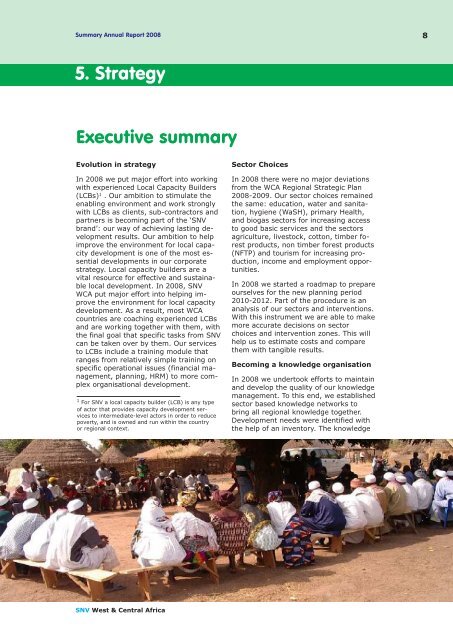download (pdf, 3MB) - SNV
download (pdf, 3MB) - SNV
download (pdf, 3MB) - SNV
Create successful ePaper yourself
Turn your PDF publications into a flip-book with our unique Google optimized e-Paper software.
Summary Annual Report 2008 8<br />
5. Strategy<br />
Executive summary<br />
Evolution in strategy<br />
In 2008 we put major effort into working<br />
with experienced Local Capacity Builders<br />
(LCBs) 1 . Our ambition to stimulate the<br />
enabling environment and work strongly<br />
with LCBs as clients, sub-contractors and<br />
partners is becoming part of the ‘<strong>SNV</strong><br />
brand’: our way of achieving lasting development<br />
results. Our ambition to help<br />
improve the environment for local capacity<br />
development is one of the most essential<br />
developments in our corporate<br />
strategy. Local capacity builders are a<br />
vital resource for effective and sustainable<br />
local development. In 2008, <strong>SNV</strong><br />
WCA put major effort into helping improve<br />
the environment for local capacity<br />
development. As a result, most WCA<br />
countries are coaching experienced LCBs<br />
and are working together with them, with<br />
the final goal that specific tasks from <strong>SNV</strong><br />
can be taken over by them. Our services<br />
to LCBs include a training module that<br />
ranges from relatively simple training on<br />
specific operational issues (financial management,<br />
planning, HRM) to more complex<br />
organisational development.<br />
1 For <strong>SNV</strong> a local capacity builder (LCB) is any type<br />
of actor that provides capacity development services<br />
to intermediate-level actors in order to reduce<br />
poverty, and is owned and run within the country<br />
or regional context.<br />
Sector Choices<br />
In 2008 there were no major deviations<br />
from the WCA Regional Strategic Plan<br />
2008-2009. Our sector choices remained<br />
the same: education, water and sanitation,<br />
hygiene (WaSH), primary Health,<br />
and biogas sectors for increasing access<br />
to good basic services and the sectors<br />
agriculture, livestock, cotton, timber forest<br />
products, non timber forest products<br />
(NFTP) and tourism for increasing production,<br />
income and employment opportunities.<br />
In 2008 we started a roadmap to prepare<br />
ourselves for the new planning period<br />
2010-2012. Part of the procedure is an<br />
analysis of our sectors and interventions.<br />
With this instrument we are able to make<br />
more accurate decisions on sector<br />
choices and intervention zones. This will<br />
help us to estimate costs and compare<br />
them with tangible results.<br />
Becoming a knowledge organisation<br />
In 2008 we undertook efforts to maintain<br />
and develop the quality of our knowledge<br />
management. To this end, we established<br />
sector based knowledge networks to<br />
bring all regional knowledge together.<br />
Development needs were identified with<br />
the help of an inventory. The knowledge<br />
<strong>SNV</strong> West & Central Africa

















